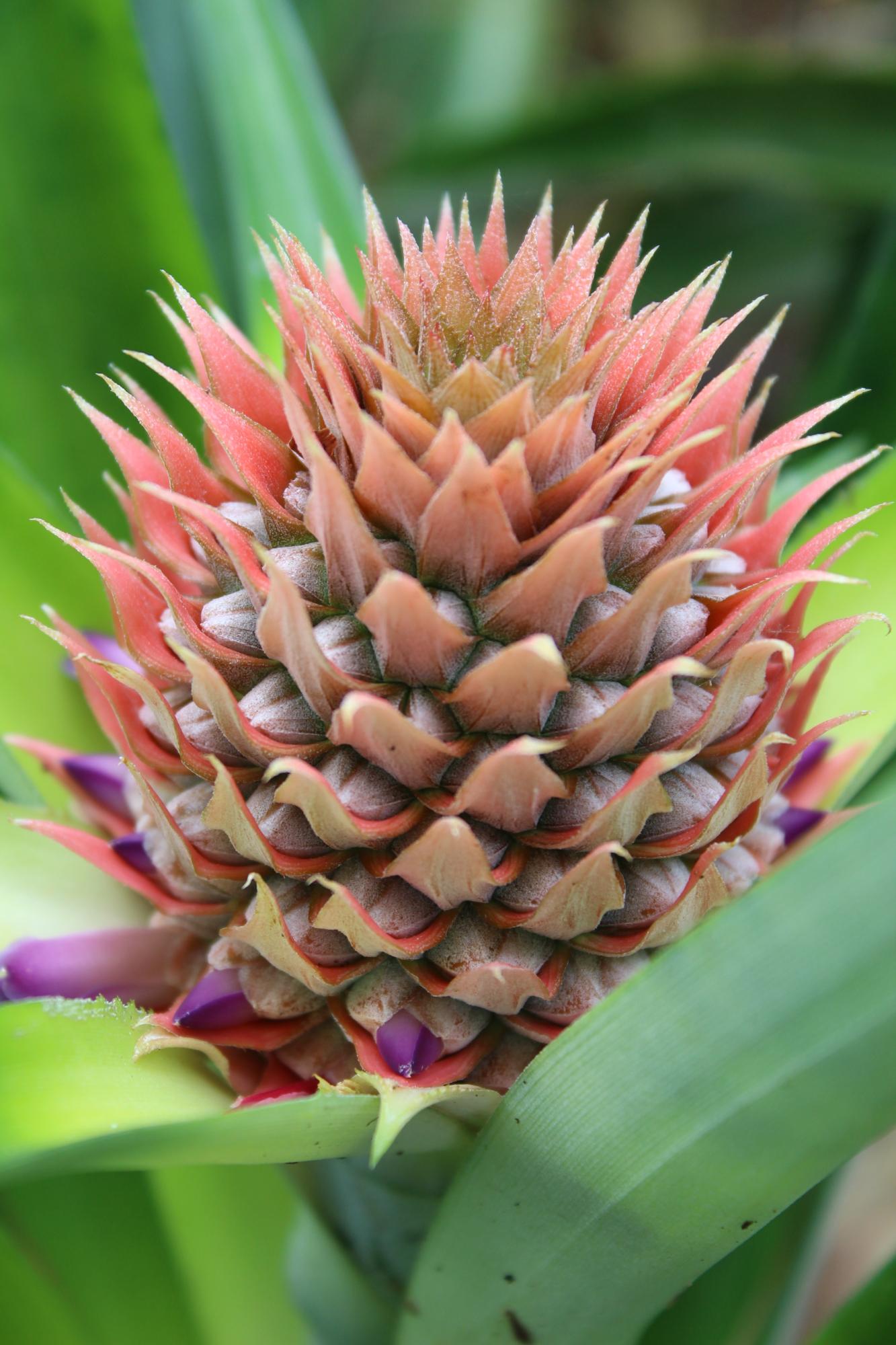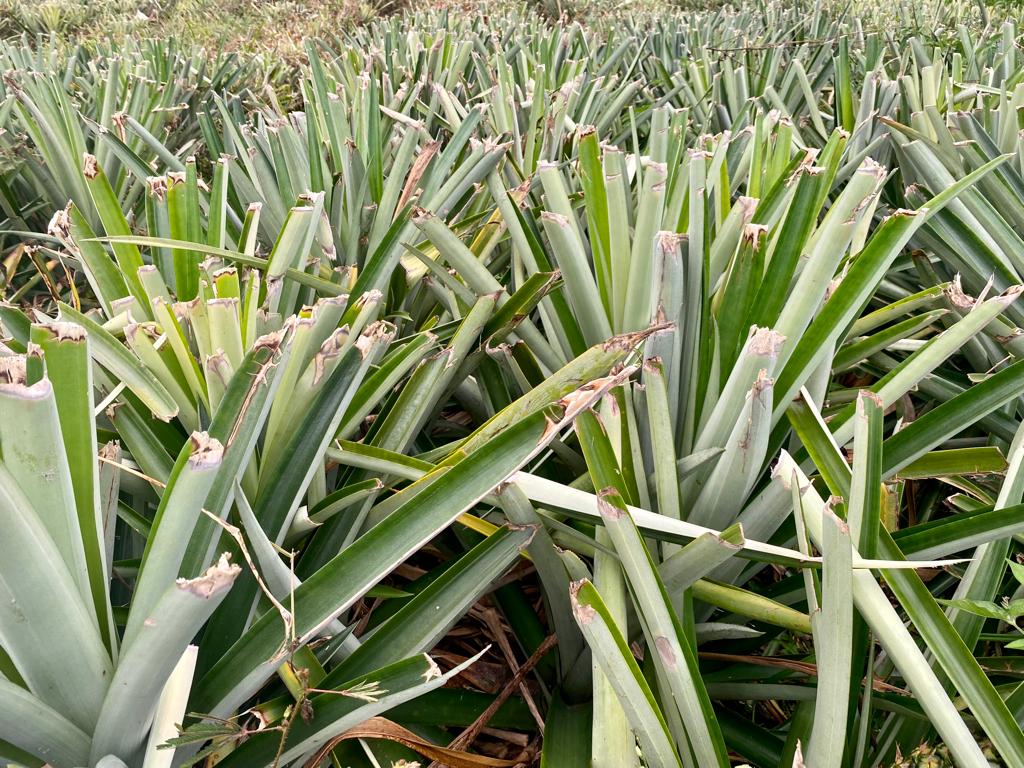Pineapple Flowering, Pollination, and Pruning

This post is also available in:
This post is also available in:
![]() Español (Spanish)
Español (Spanish) ![]() Français (French)
Français (French) ![]() Deutsch (German)
Deutsch (German) ![]() हिन्दी (Hindi)
हिन्दी (Hindi) ![]() العربية (Arabic)
العربية (Arabic) ![]() 简体中文 (Chinese (Simplified))
简体中文 (Chinese (Simplified)) ![]() Português (Portuguese (Brazil))
Português (Portuguese (Brazil))
Pineapple Flowering and Pollination
The flowers are not externally visible for 45–60 days after planting (1). From the apical meristem, pineapple flowers grow in ascending order for up to 15 days (2). The inflorescence is made up of 50 to 200 individual flowers that include both male and female reproductive organs and are borne spirally and crowned by a crown made up of 150 leaves that are much smaller than normal pineapple leaves. The flowering stage is called the “red heart” because of the red bracts that grow at the stem base. These bracts are shorter and thinner than normal leaves.

Forcing in Pineapples – Ethylene applications for Artificial Flower Induction
Natural flowering is a major problem in pineapples, especially in the cold season, in plants that are approximately a year old and weigh >500 g (17.6 oz), which can cause uneven natural flowering. To avoid that, artificial induction with chemical forcing agents is a standard commercial practice consisting of naphthalene acetic acid and ethylene application (3). A concentration of 2.272 kg per hectare (2 lb/acre) of ethylene gas sprayed with 7000 L of water per hectare (2,800 L/acre) is highly recommended for commercial flower induction (Bartholomew et al., 2003).
Pollination
Farmers should not worry much about pollination in pineapples because, as shown by several studies, pollination is not needed for fruit set in pineapples. After all, pineapple flowers are self-sterile, and fruit development is parthenocarpic, meaning that it does not require fertilization (e.g., from another flower) to produce fruits (4). The most important pollinators of pineapples are hummingbirds and honeybees. Native bees, ants, bats, and pineapple beetles pollinate pineapples, but only in small amounts and not over long distances (Office of Gene technology regulator, 2008; 5). In most cases, pollination and cross-fertilization with other varieties are not desirable in pineapple cultivation since they will lead to seed formation and decrease fruit quality. For this reason, farmers choose to plant 1 variety per field (or even per region) and avoid planting pineapples in regions with high hummingbird populations.
Pineapple Pruning
Pineapple pruning is another activity that should not be neglected since it contributes to the uniformity of the plant in the sense that it encourages even development throughout the plant, particularly before flower induction. Heterogeneity in fruit size and taste is a major problem in pineapple cultivation globally. On the contrary, when plants develop at the same rate, there is less competition for available resources like nutrients and sunshine. Generally, the best time to prune a pineapple plant to maintain its shape and height is 2 months after harvest. Avoid pruning the trees during their dormancy.

Pruned-trimmed pineapple plants after harvest
The trimming of the plants can be done by using a sharp panga knife some months before the flower induction. Furthermore, one or two suckers, or sometimes more, are produced by pineapple plants during the last stages of fruit development (6). If the mother plant has several suckers, it is better to cut them off with a sharp knife (machete). After harvesting suckers, slips, and hapas, they should be removed from the mother plant so that there is exactly one sucker per mother plant since that yields the highest quality ratoons. Suckers with an average weight of 1 lb. (0.454 kg) can be kept as planting materials after being removed from the mother plant.
References
(1)Bartholomew, D.P., Paull, R.E. and Rohrbach, K.G. (2003). The Pineapple: Botany, Production, and Uses. CABI, Wallingford. https://doi.org/10.1079/9780851995038.0000
(2) Office of Gene technology regulator (Government of Australia). (2008). The biology of
Ananas comosus var. comosus. (Pineapple). https://www.ogtr.gov.au/sites/default/files/files/2021-07/the_biology_of_pineapple.pdf
(3) Burg SP, Burg EA. Auxin-induced ethylene formation: its relation to flowering in the pineapple. Science. 1966 May 27;152(3726):1269. doi: 10.1126/science.152.3726.1269. PMID: 5937118.
(4) Kwapong, P., & Kudom, A. (2010). Floral visitors of Ananas comosus in Ghana: A preliminary assessment. Journal of Pollination Ecology, 2, 27–32. https://doi.org/10.26786/1920-7603(2010)4
(5) https://www.daf.qld.gov.au/business-priorities/agriculture/plants/fruit-vegetable/fruit-vegetable-crops/pineapples/faqs-about-pineapples/faqs-about-planting-pineapple
(6) Robert Bevacqua R., Tuquero J., & Bamba J. (2015). Growing pineapples in Guam. University of Guam. https://www.uog.edu/_resources/files/extension/publications/Pineapple-Book_Final_3_16-1.pdf
Pineapple History, Uses and Nutritional Value
Pineapples Plant Information and Environmental Requirements
Soil Requirements and Land Preparation for Pineapple
Planting of Pineapple – Pineapple Plant Density
Pineapple Water Needs and Irrigation Systems
Pineapple Fertilization Requirements
Pineapple Flowering, Pollination, and Pruning








































































